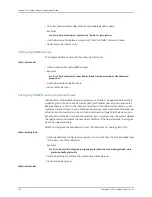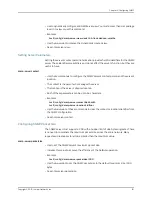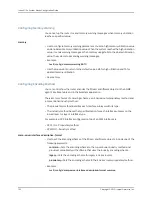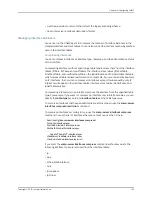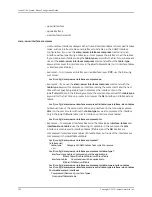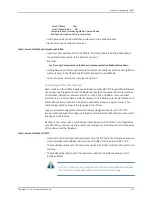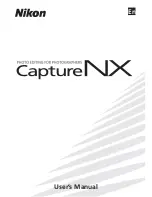
•
drainRate
—Specifies the maximum number of traps per second sent to the host
•
full
—Specifies the method for handling the queue full condition
•
size
—Specifies the maximum number of traps kept in the queue
•
Example
host1(config)#
snmp-server host 10.10.10.10 trapqueue drainrate 600 full droplastin
size 50
•
Use the
no
version to remove the SNMP host.
•
See snmp-server host.
Configuring Trap Notification Logs
SNMP uses the User Datagram Protocol (UDP) to send traps. Because UDP does not
guarantee delivery or provide flow control, some traps can be lost in transit to a destination
address. The Notification Log MIB provides flow control support for UDP datagrams.
You should set up your management applications to periodically request the recorded
traps to ensure that the host is up and the management applications have received all
the generated traps.
To identify the location of traps logged in the notification log, the system assigns a
consecutive index number to each SNMP trap message transmitted from the E Series
router. Clients can use the index to detect missing traps.
To configure trap notification logs:
1.
Configure the notification log.
host1(config)
snmp-server notificationlog log 10.10.4.4 adminStatus includeVarbinds
2.
(Optional) Specify when the notification log ages out.
host1(config)#
snmp-server notificationlog ageout 5
3.
(Optional) Specify the maximum number of entries kept in the notification log.
host1(config)#
snmp-server notificationlog entrylimit 210
4.
(Optional) Enable the snmpTrap log to severity level info.
host1(config)#
log severity info snmpTrap
NOTE:
Enabling the snmpTrap log provides the same information in the
router log as appears in the snmp-server notification log. However, long
trap strings may appear truncated.
log severity
Copyright © 2010, Juniper Networks, Inc.
164
JunosE 11.3.x System Basics Configuration Guide
Summary of Contents for JUNOSE 11.3
Page 6: ...Copyright 2010 Juniper Networks Inc vi...
Page 8: ...Copyright 2010 Juniper Networks Inc viii JunosE 11 3 x System Basics Configuration Guide...
Page 24: ...Copyright 2010 Juniper Networks Inc xxiv JunosE 11 3 x System Basics Configuration Guide...
Page 32: ...Copyright 2010 Juniper Networks Inc 2 JunosE 11 3 x System Basics Configuration Guide...
Page 146: ...Copyright 2010 Juniper Networks Inc 116 JunosE 11 3 x System Basics Configuration Guide...
Page 166: ...Copyright 2010 Juniper Networks Inc 136 JunosE 11 3 x System Basics Configuration Guide...
Page 432: ...Copyright 2010 Juniper Networks Inc 402 JunosE 11 3 x System Basics Configuration Guide...
Page 488: ...Copyright 2010 Juniper Networks Inc 458 JunosE 11 3 x System Basics Configuration Guide...
Page 524: ...Copyright 2010 Juniper Networks Inc 494 JunosE 11 3 x System Basics Configuration Guide...
Page 554: ...Copyright 2010 Juniper Networks Inc 524 JunosE 11 3 x System Basics Configuration Guide...
Page 566: ...Copyright 2010 Juniper Networks Inc 536 JunosE 11 3 x System Basics Configuration Guide...
Page 588: ...Copyright 2010 Juniper Networks Inc 558 JunosE 11 3 x System Basics Configuration Guide...
Page 613: ...PART 3 Index Index on page 585 583 Copyright 2010 Juniper Networks Inc...
Page 614: ...Copyright 2010 Juniper Networks Inc 584 JunosE 11 3 x System Basics Configuration Guide...
Page 632: ...Copyright 2010 Juniper Networks Inc 602 JunosE 11 3 x System Basics Configuration Guide...

